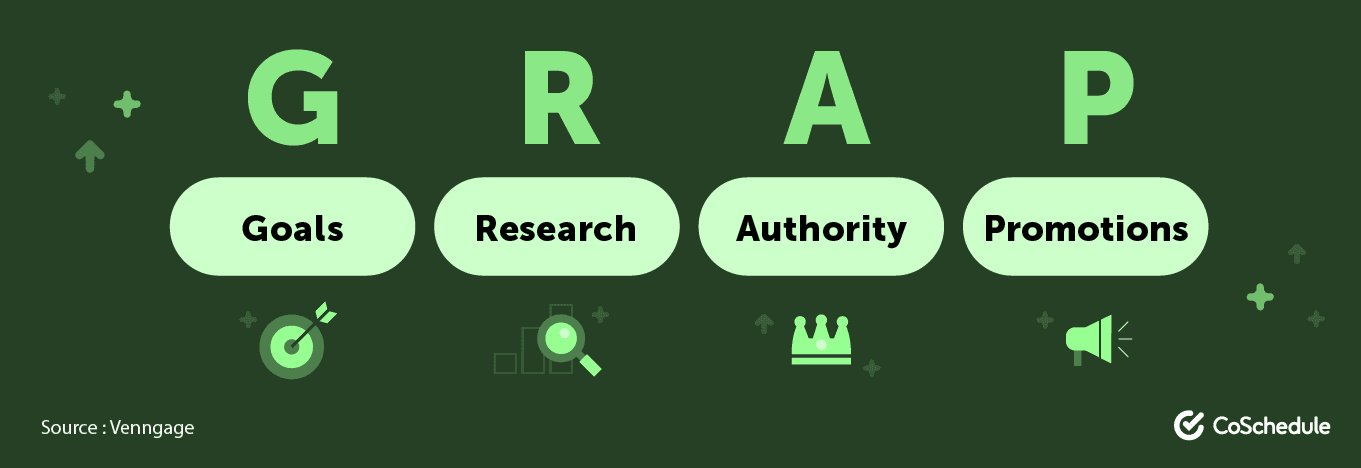GRAP Framework: How to Increase Web Traffic Without a Huge Budget
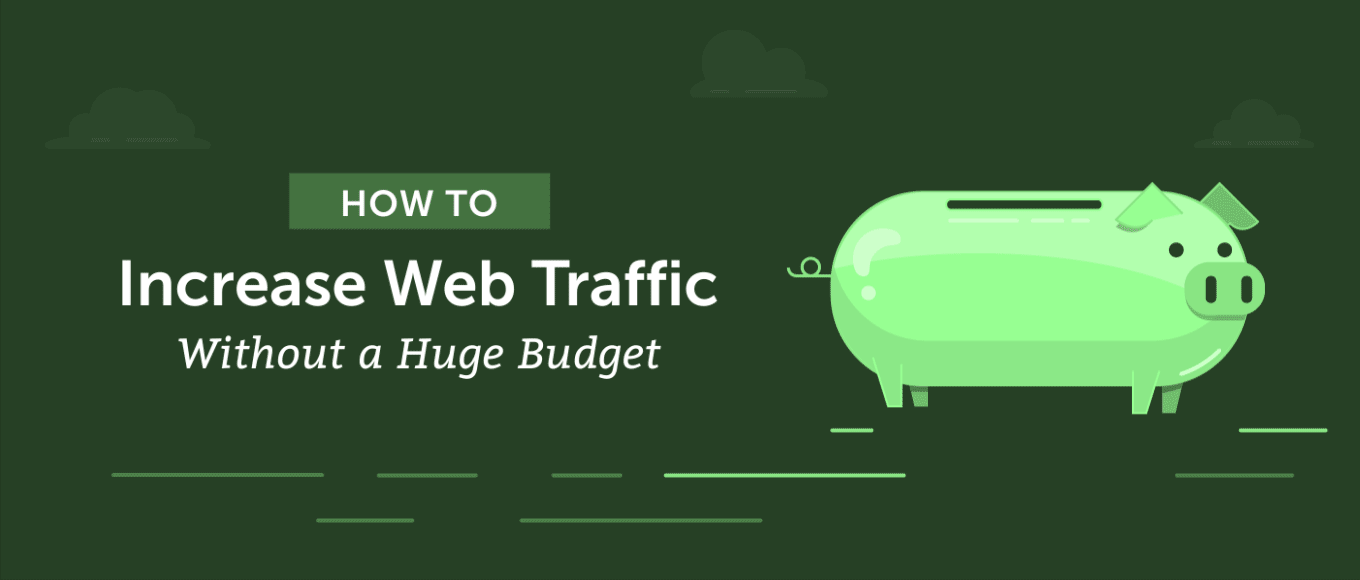 Stop me if you’ve heard this before. You created a marketing plan, outlined your content strategy and even allocated a chunk of your marketing budget to your content strategy.
You now spend the next 6 months working tirelessly creating content, promoting it and waiting in the hopes that your content will attract the right audience. And, 6 months later you’re still where you were when you started.
Stop me if you’ve heard this before. You created a marketing plan, outlined your content strategy and even allocated a chunk of your marketing budget to your content strategy.
You now spend the next 6 months working tirelessly creating content, promoting it and waiting in the hopes that your content will attract the right audience. And, 6 months later you’re still where you were when you started.
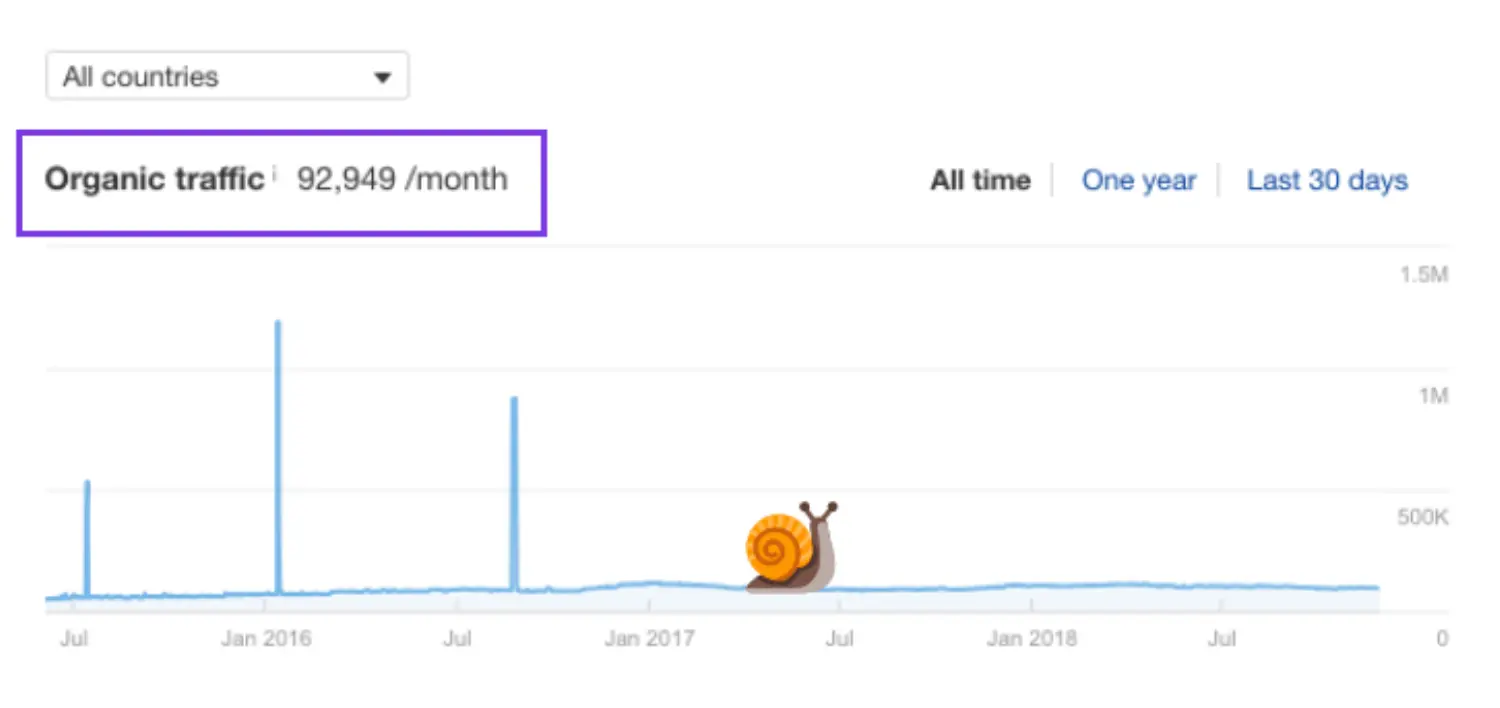 No backlinks, abysmal traffic (if any) and customers you can count on your hands.
So, how do you increase web traffic without a huge marketing budget and drive the right business results?
Well, you’re in luck. Because I’m going to share the content marketing framework Venngage used to grow increase web traffic 3x in under a year. In this post you’ll learn:
No backlinks, abysmal traffic (if any) and customers you can count on your hands.
So, how do you increase web traffic without a huge marketing budget and drive the right business results?
Well, you’re in luck. Because I’m going to share the content marketing framework Venngage used to grow increase web traffic 3x in under a year. In this post you’ll learn:
- How Venngage grew 150% YoY from 2015 till today. And how you can achieve the same results with your content strategy without a huge budget.
- How Venngage approaches content marketing. Learn how we establish specific goals for specific pieces of content. Because not all content is created equal.
- How to systemize content marketing to drive tangible results. And why writing quality content is only half the battle.
GRAP Framework: How to Increase Web Traffic Without a Huge Budget
Click To TweetDownload the Complete GRAP Framework Slidedeck
If you'd like to see the original slides from Venngage's Nadya Khoja, you can download them now (then read on to learn how to apply this process to increase your web traffic):
Table of Contents:How Did We Get Here?
Increase Web Traffic with the GRAP Framework
1. Goals
2. Research
3. Authority
4. Promotion
Applying the GRAP Framework
Bringing It All Together
How Did We Get Here?
Before we dive into the nitty-gritties, we need a little backstory as to what Venngage is, why I’m writing this guide or better yet to address the question, “why should I care?” Our Chief Growth Officer (and my mentor) Nadya Khoja joined Venngage way back in 2015 as Employee #4. And Marketer #1.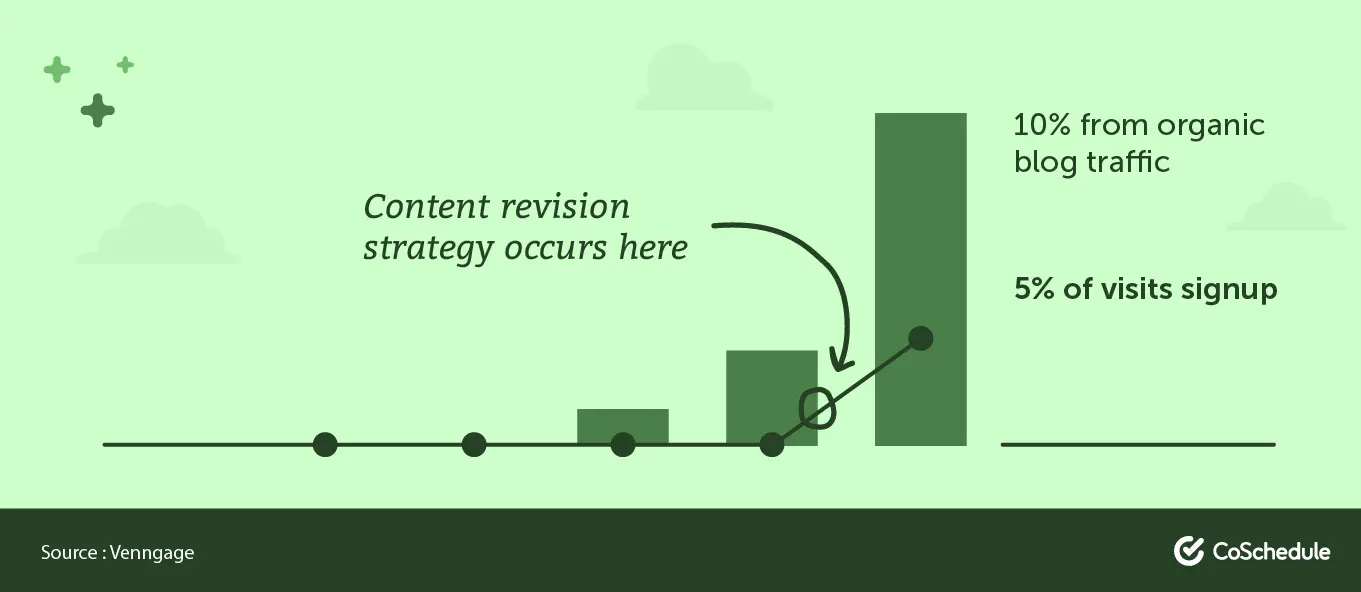 When Nadya started, Venngage was generating roughly 400 signups per week. Fast forward to today we generate close to 40,000 signups to our tool on a weekly basis.
In 2015 we also drove a respectable 25 upgrades (paying customers) on a weekly basis, while today we drive over 700 upgrades a week.
To sum it all up, we’ve achieved rapid growth since 2015 with an average growth rate of 150% YoY up until this point. Did I also mention we’re completely bootstrapped?
When Nadya started, Venngage was generating roughly 400 signups per week. Fast forward to today we generate close to 40,000 signups to our tool on a weekly basis.
In 2015 we also drove a respectable 25 upgrades (paying customers) on a weekly basis, while today we drive over 700 upgrades a week.
To sum it all up, we’ve achieved rapid growth since 2015 with an average growth rate of 150% YoY up until this point. Did I also mention we’re completely bootstrapped?
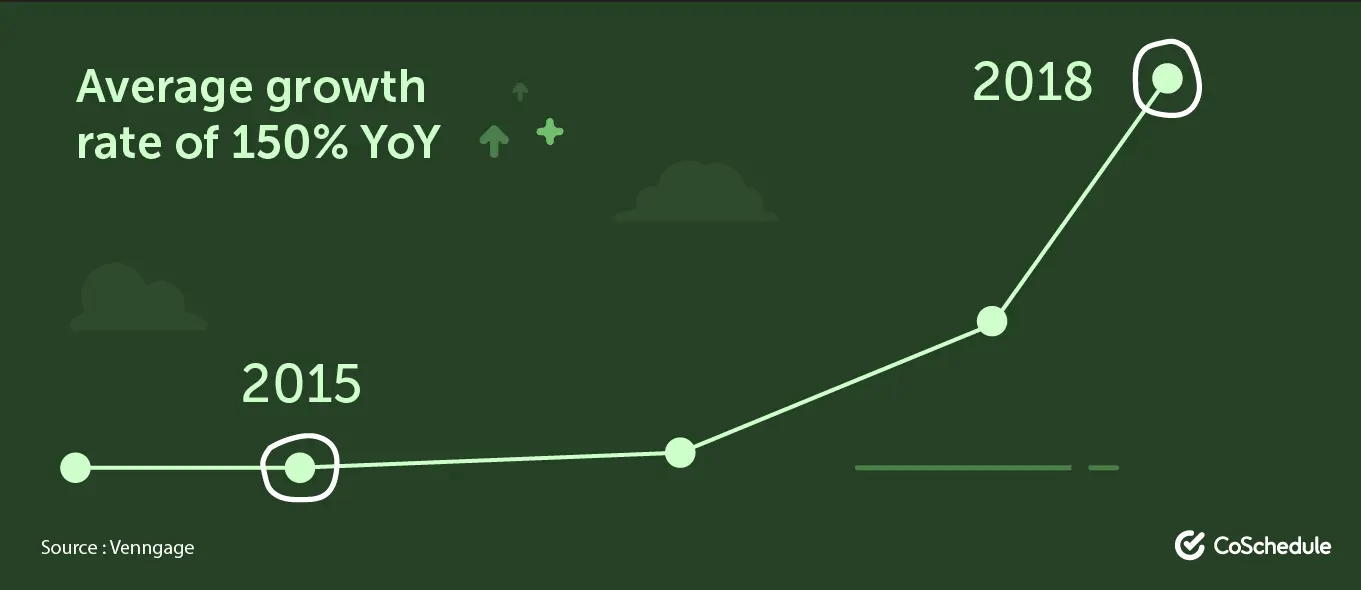 These are the kind of business results Nadya and our content team (shoutout to Sara McGuire & Ryan McCready) drove at Venngage based on the growth strategy they created during the early days.
But how did they accomplish all this? One word: Content Marketing.
But does content marketing even work in this day and age? You’ve probably stumbled across any or all the following arguments against content marketing in your marketing career:
These are the kind of business results Nadya and our content team (shoutout to Sara McGuire & Ryan McCready) drove at Venngage based on the growth strategy they created during the early days.
But how did they accomplish all this? One word: Content Marketing.
But does content marketing even work in this day and age? You’ve probably stumbled across any or all the following arguments against content marketing in your marketing career:
- Content Marketing takes too long to convert.
- Content Marketing takes too long to see the right results.
- Content Marketing isn’t a scalable marketing channel.
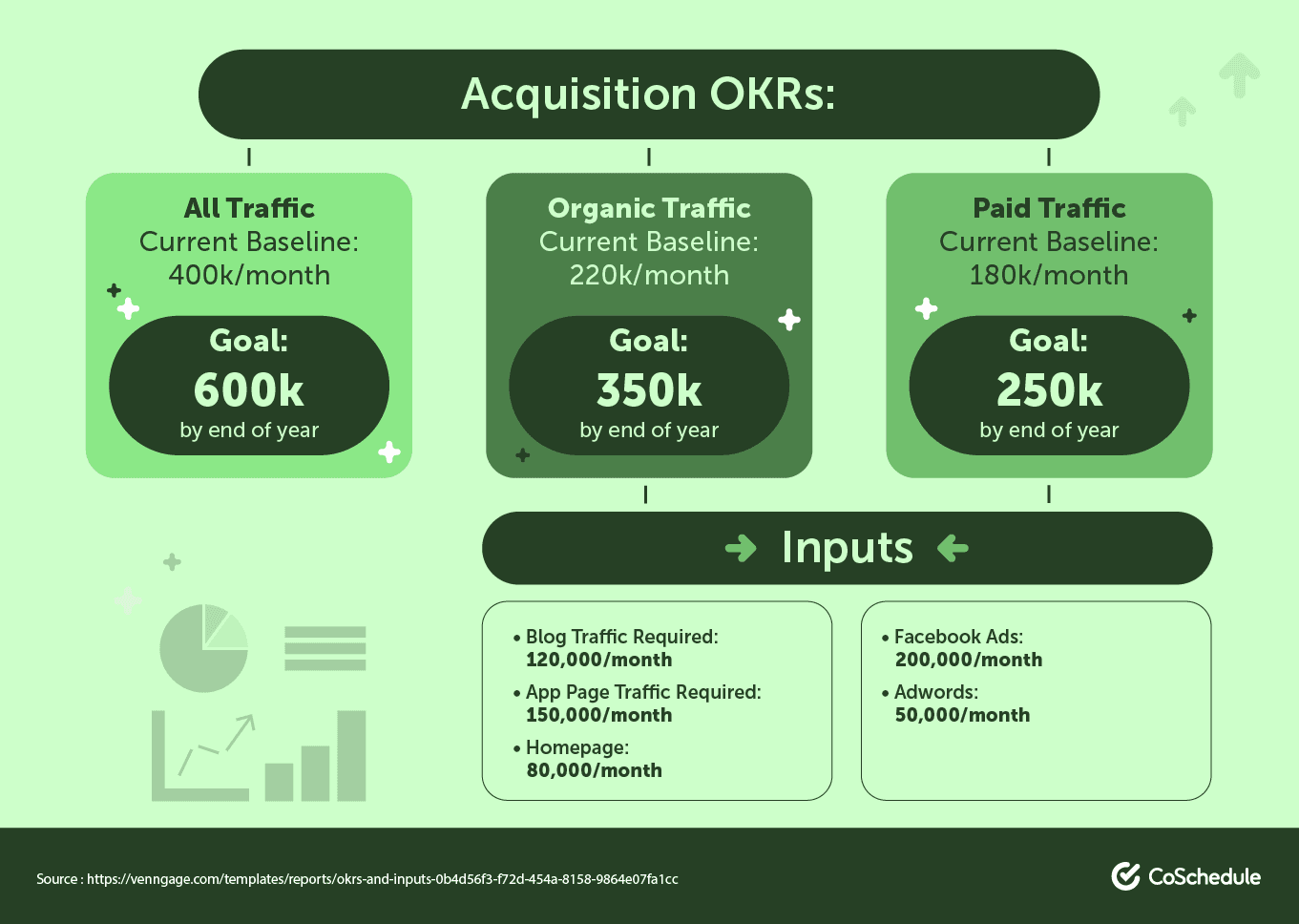 Source
Driving organic traffic back to the site through content still our main acquisition channel. The other acquisition channels barely play second fiddle. And we spend barely anything on paid ads.
But what do most marketers or growth teams end up doing? Spend money on paid acquisition, primarily because they generate results faster and are often easier to pull off.
But here are my arguments for marketers resisting organic traffic in favour of paid:
Source
Driving organic traffic back to the site through content still our main acquisition channel. The other acquisition channels barely play second fiddle. And we spend barely anything on paid ads.
But what do most marketers or growth teams end up doing? Spend money on paid acquisition, primarily because they generate results faster and are often easier to pull off.
But here are my arguments for marketers resisting organic traffic in favour of paid:
- What if you’re an early stage company that cannot afford to spend on paid ads?
- What is your Customer Lifetime Value isn’t high enough to sustain your paid endeavours?
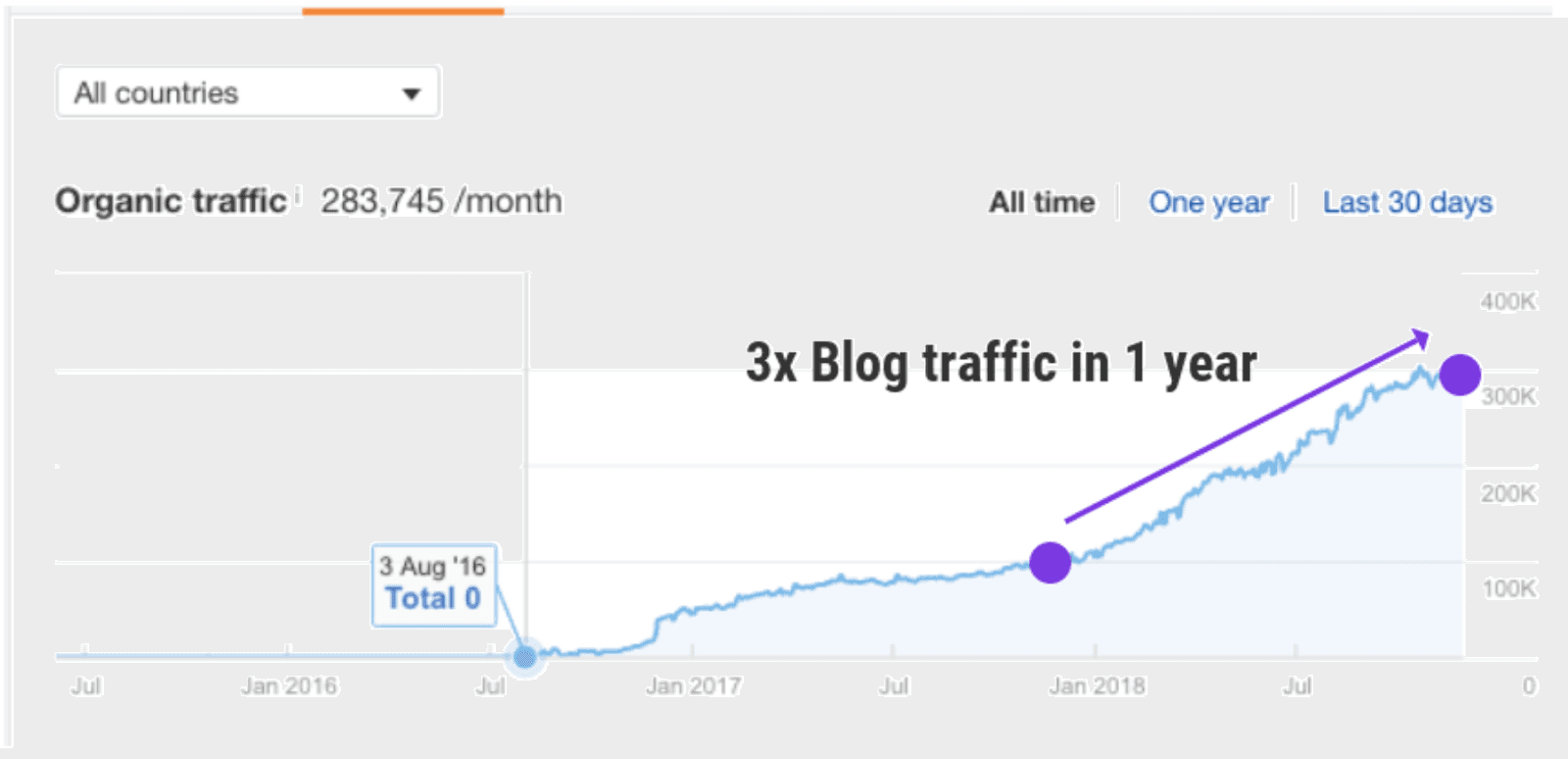 Short answer: By systemizing our current content marketing strategy, establishing specific goals for specific pieces of content, streamlining our content marketing workflow and putting more focus on promotion over content creation we’ve been able to achieve predictable and sustainable organic growth. The keyword being, “predictable”.
But without a deep dive, this wouldn't be an actionable guide now would it? So let’s get right down to brass tacks.
Short answer: By systemizing our current content marketing strategy, establishing specific goals for specific pieces of content, streamlining our content marketing workflow and putting more focus on promotion over content creation we’ve been able to achieve predictable and sustainable organic growth. The keyword being, “predictable”.
But without a deep dive, this wouldn't be an actionable guide now would it? So let’s get right down to brass tacks.
1. Goals
The first part of the GRAP Framework is high level goal setting, setting specific goals for your content strategy and then putting in the work to impact your high level growth goals. How content marketing has traditionally worked in the distant past is: you create content, build links to said content and hope for the best. This is the wrong way to approach content marketing. Why? Because not all content is created equal or created for the same purpose. To explain further, check out this simple flowchart shows how you can ideally “win” at google: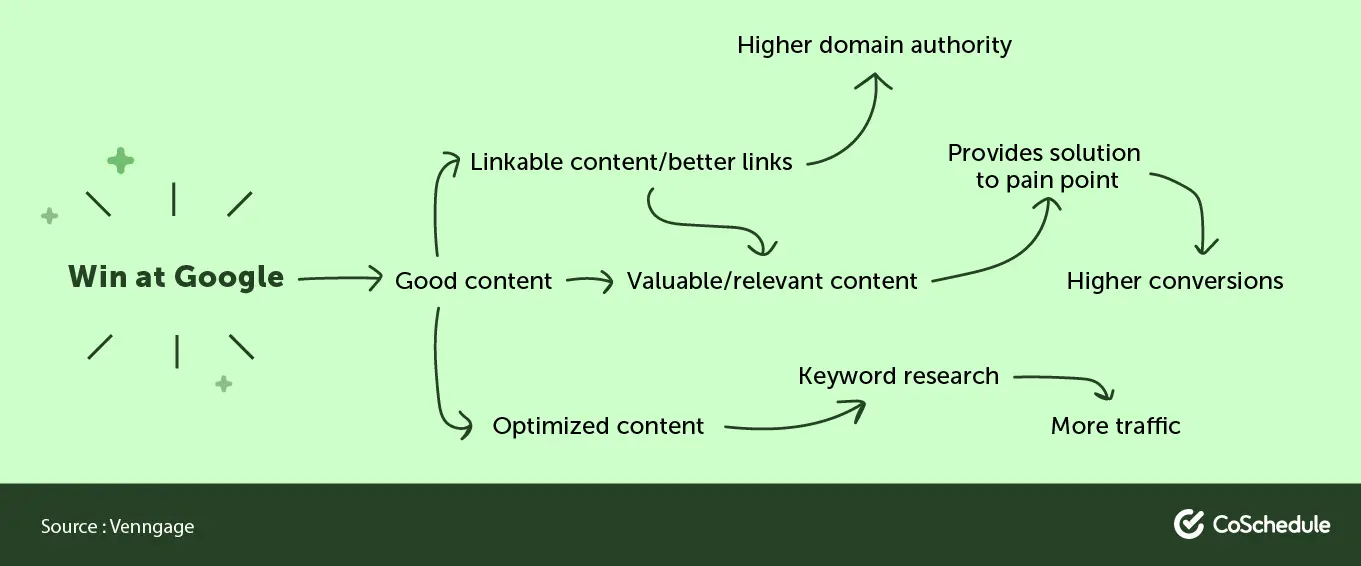 What did we do here? We established 3 simple end points:
What did we do here? We established 3 simple end points:
- Increase web traffic.
- Increase DA.
- Boost conversions.
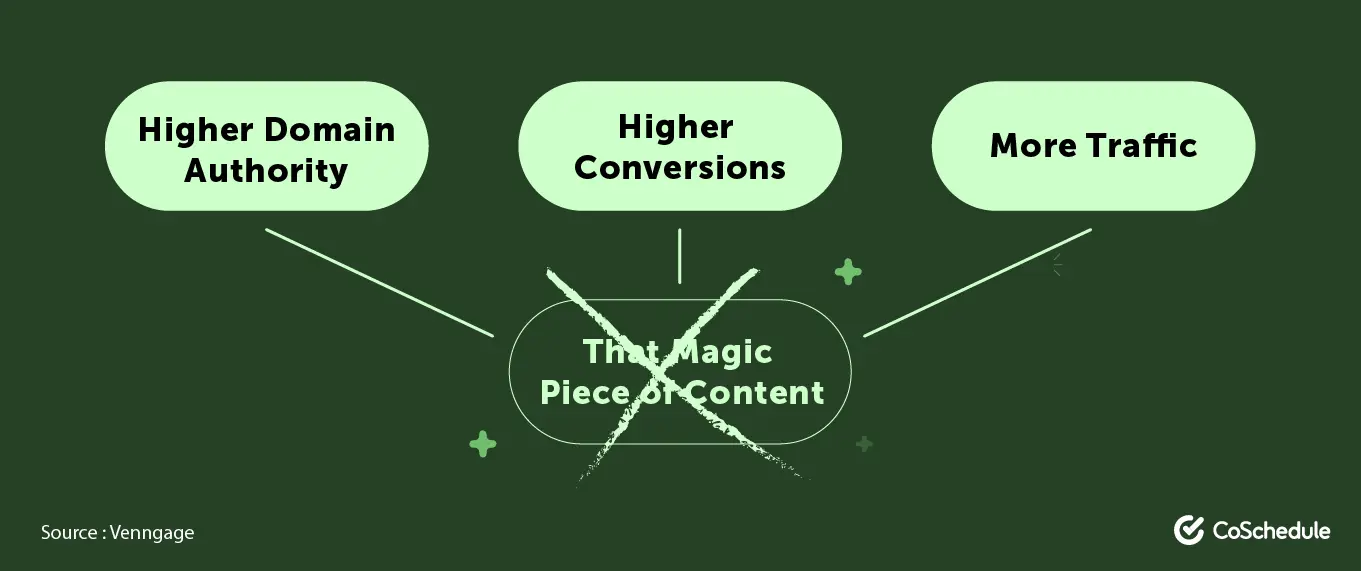 Meaning, you need to stop relying on the same outdated process for content creation in hopes to achieve various goals at the same time.
Instead, create specific pieces of content with the aim of achieving specific goals.
For example: you have a product/service that falls in a relatively niche industry, and maybe you’re great at creating content that’s optimized for conversions or maybe it’s just easier to do that.
But, since your product/service is so niche, it may be hard to increase web traffic. So the type of content you’re producing is only helping you achieve higher conversions, not more traffic or improving your DA (domain authority).
Here’s an overview of how Venngage approaches goal setting for our content:
Meaning, you need to stop relying on the same outdated process for content creation in hopes to achieve various goals at the same time.
Instead, create specific pieces of content with the aim of achieving specific goals.
For example: you have a product/service that falls in a relatively niche industry, and maybe you’re great at creating content that’s optimized for conversions or maybe it’s just easier to do that.
But, since your product/service is so niche, it may be hard to increase web traffic. So the type of content you’re producing is only helping you achieve higher conversions, not more traffic or improving your DA (domain authority).
Here’s an overview of how Venngage approaches goal setting for our content:
- Viral/editorial content: The goal is nab those elusive press links and boost our domain authority.
- Inspirational content: The goal is to increase web traffic by ranking for various high volume keywords.
- Actionable content/how to guides: The goal is to improve conversions or activations by solving customer pain points and educating users.
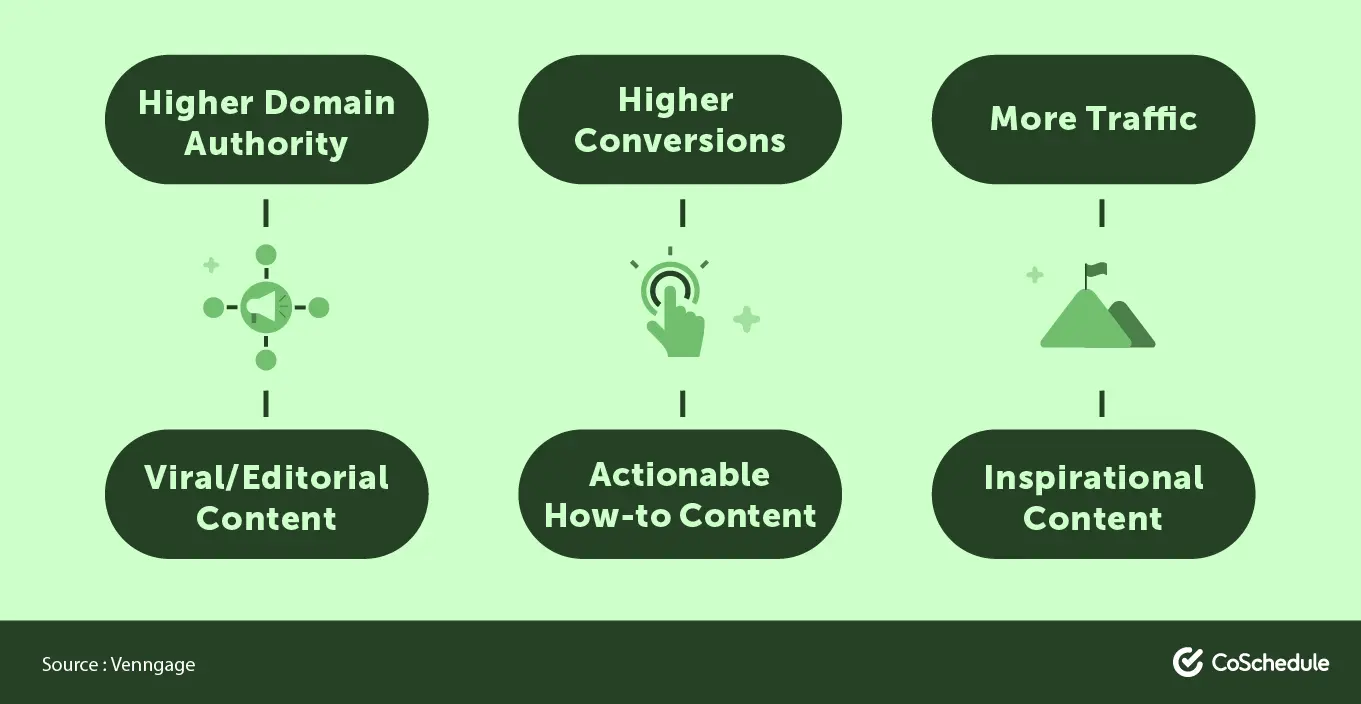 So if your goal is to boost your domain authority or landing high quality press mentions from notable sites like Mashable, Forbes, Entrepreneur, etc you need a different piece of content to achieve that.
Based on this rationale, these sites will not link to an actionable piece of content or a how-to guide on “Simple Backgrounds & Design Tips”.
So if your goal is to boost your domain authority or landing high quality press mentions from notable sites like Mashable, Forbes, Entrepreneur, etc you need a different piece of content to achieve that.
Based on this rationale, these sites will not link to an actionable piece of content or a how-to guide on “Simple Backgrounds & Design Tips”.
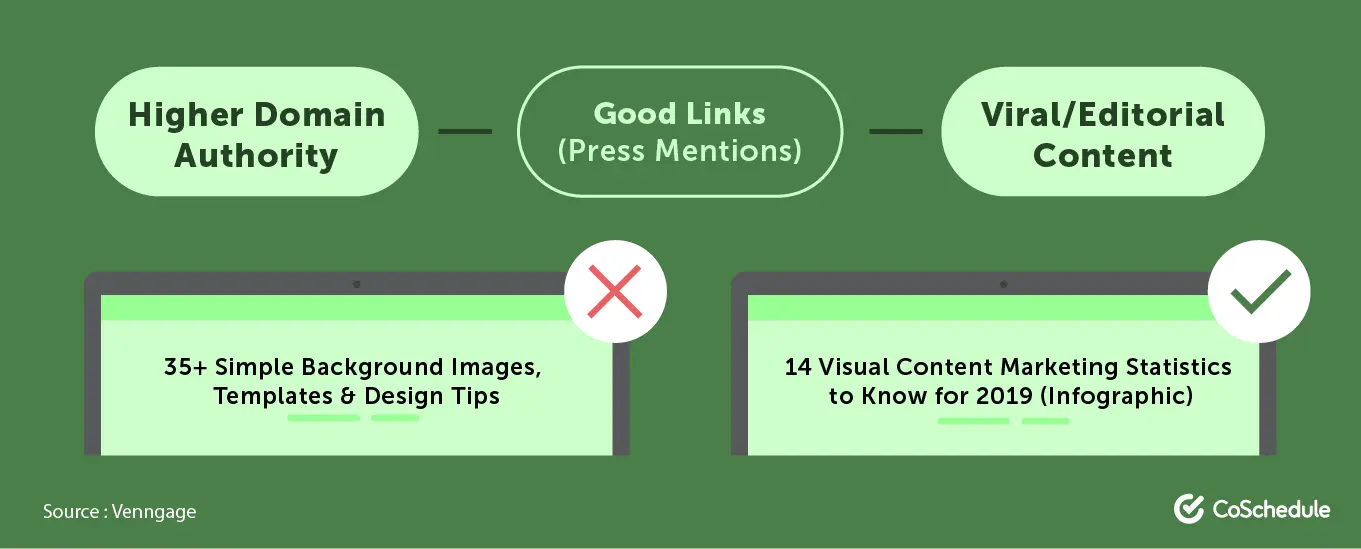 But they will probably link to something more appealing like, “Visual Content Marketing Statistics” for that matter which is a great example of viral/editorial content.
But they will probably link to something more appealing like, “Visual Content Marketing Statistics” for that matter which is a great example of viral/editorial content.
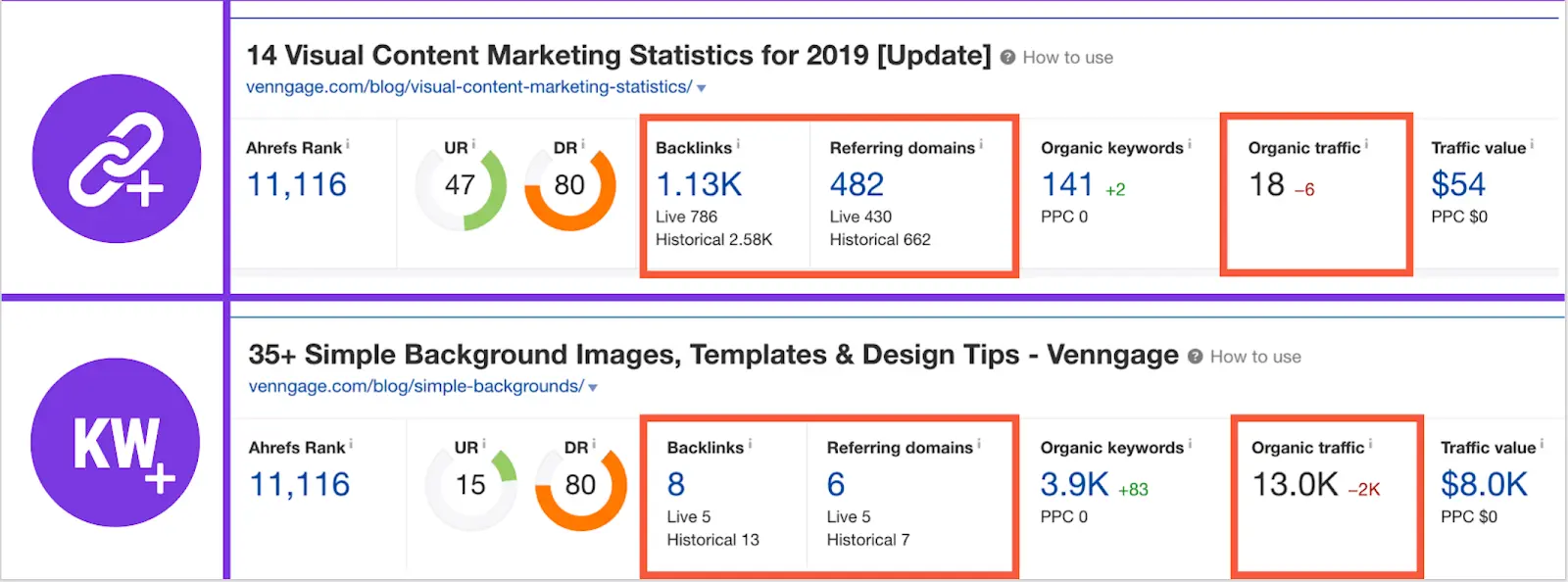 Here’s the real kicker.
The same “Simple Backgrounds & Design Tips” post from before is ranking for tons of keywords and increasing our web traffic even though it has only a few backlinks.
In a nutshell, content that’s optimized for landing press links is not the same content that’s going to increase web traffic. Makes sense right?
Want to know how to create viral content? Watch Nadya’s video to learn how she approaches it:
Here’s the real kicker.
The same “Simple Backgrounds & Design Tips” post from before is ranking for tons of keywords and increasing our web traffic even though it has only a few backlinks.
In a nutshell, content that’s optimized for landing press links is not the same content that’s going to increase web traffic. Makes sense right?
Want to know how to create viral content? Watch Nadya’s video to learn how she approaches it:
“You need a strategic approach to content”.
2. Research
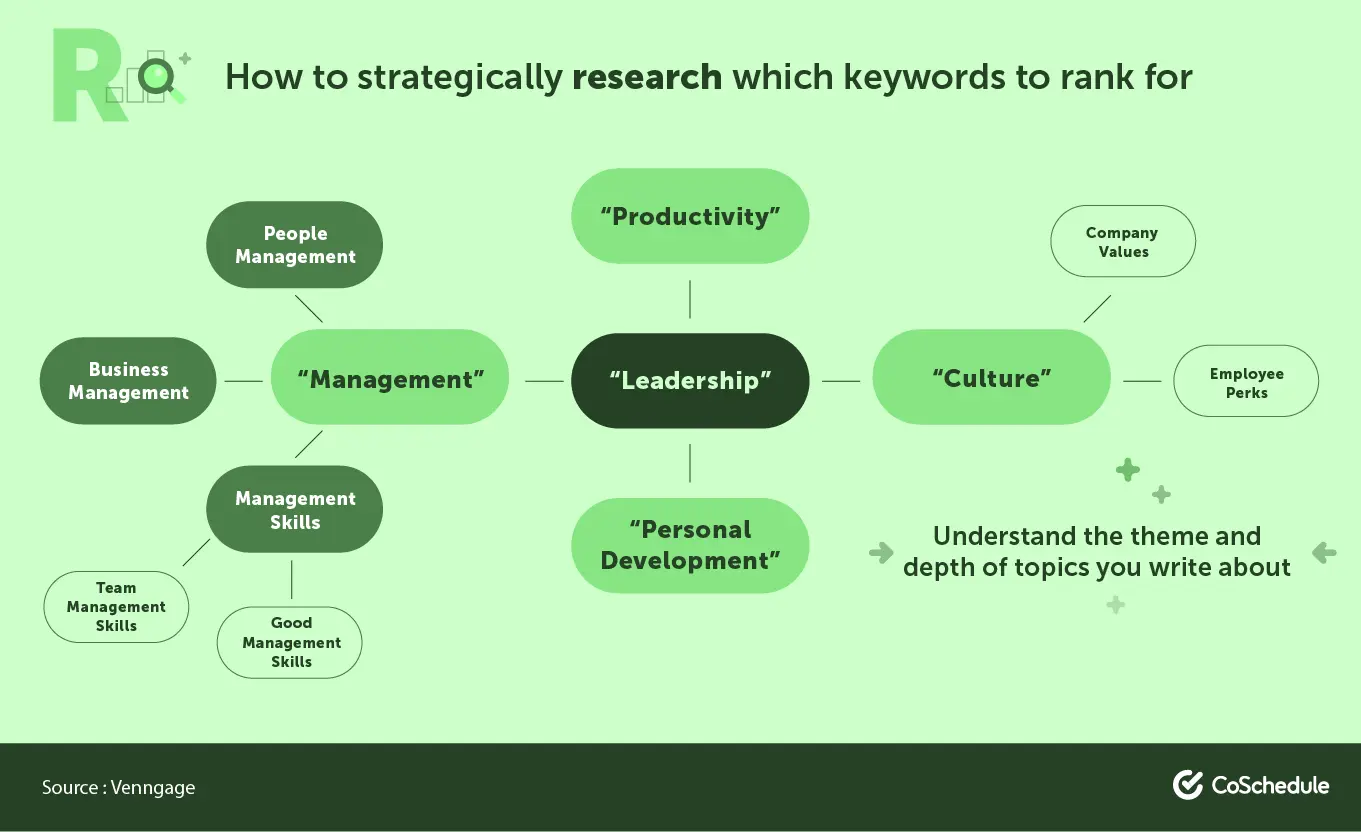 We talked about the 3 types of goals to strive for with your content, but the next part of this framework is research.
And we do this by developing a system to identify which keywords to rank for. Approaching content marketing without doing keyword research is pointless.
So many marketers spend enormous amounts of time, money and effort creating all this content aimed at acquiring users, increasing web traffic, etc but the results are almost always abysmal.
Why? Because they forget to do keyword research. So here is a golden rule:
“Content creation should always start with keyword research”.
Because that way, at the very least you give yourself a solid headstart when it comes to increasing web traffic.
In SEO/Content marketing, there’s really only 2 types of pages you’re trying to promote:
We talked about the 3 types of goals to strive for with your content, but the next part of this framework is research.
And we do this by developing a system to identify which keywords to rank for. Approaching content marketing without doing keyword research is pointless.
So many marketers spend enormous amounts of time, money and effort creating all this content aimed at acquiring users, increasing web traffic, etc but the results are almost always abysmal.
Why? Because they forget to do keyword research. So here is a golden rule:
“Content creation should always start with keyword research”.
Because that way, at the very least you give yourself a solid headstart when it comes to increasing web traffic.
In SEO/Content marketing, there’s really only 2 types of pages you’re trying to promote:
- Boring pages: High converting landing pages that are hard to build links to.
- Not boring pages: Blog content or other ungated content pieces.
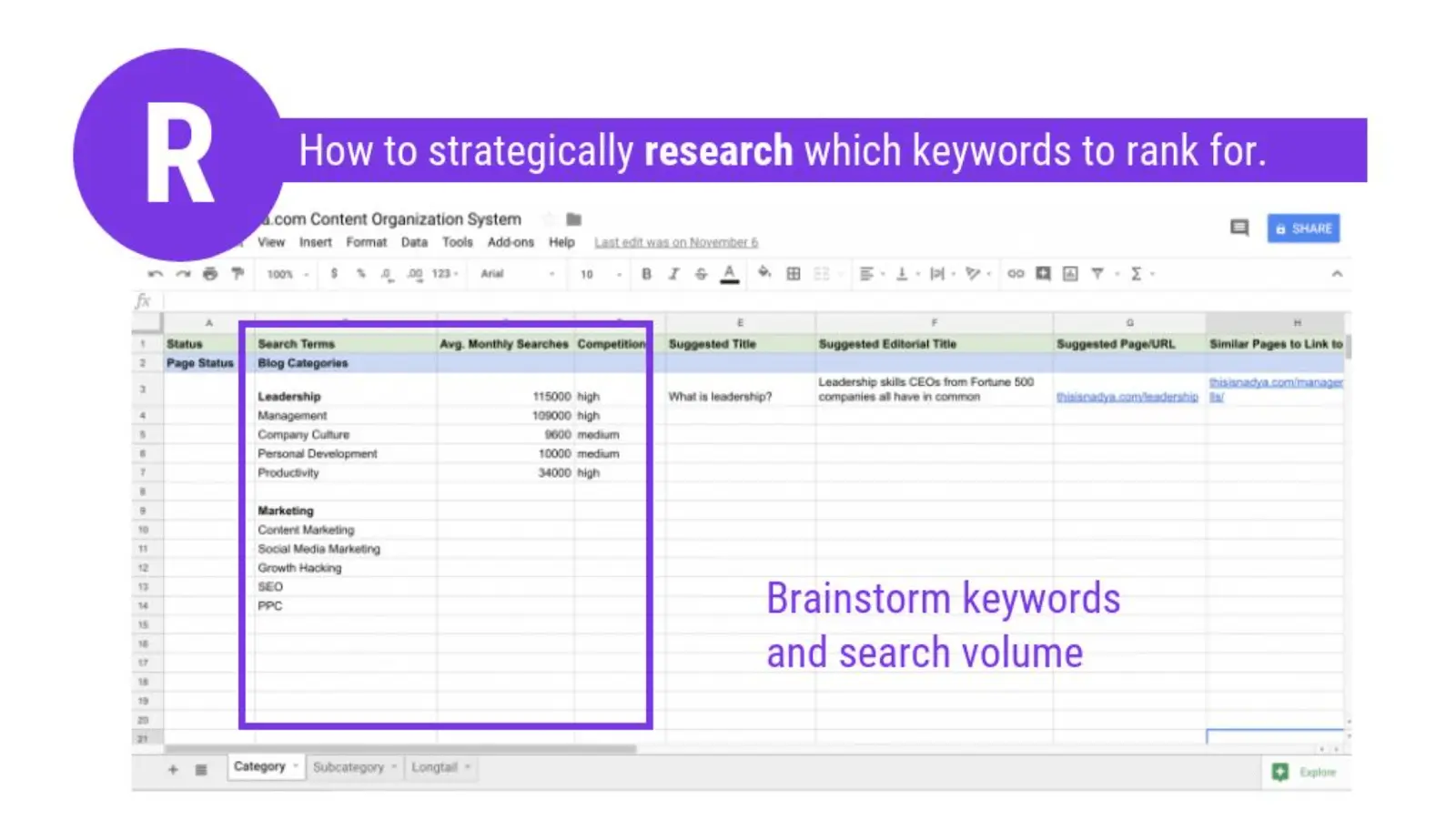 And essentially give you a better idea of the range/diversity of content you can write about as it pertains to your audience’s interests.
That way you eliminate the guesswork and potential time waste resulting from writing anything about everything, you are going to write content that people are actually searching for.
And essentially give you a better idea of the range/diversity of content you can write about as it pertains to your audience’s interests.
That way you eliminate the guesswork and potential time waste resulting from writing anything about everything, you are going to write content that people are actually searching for.
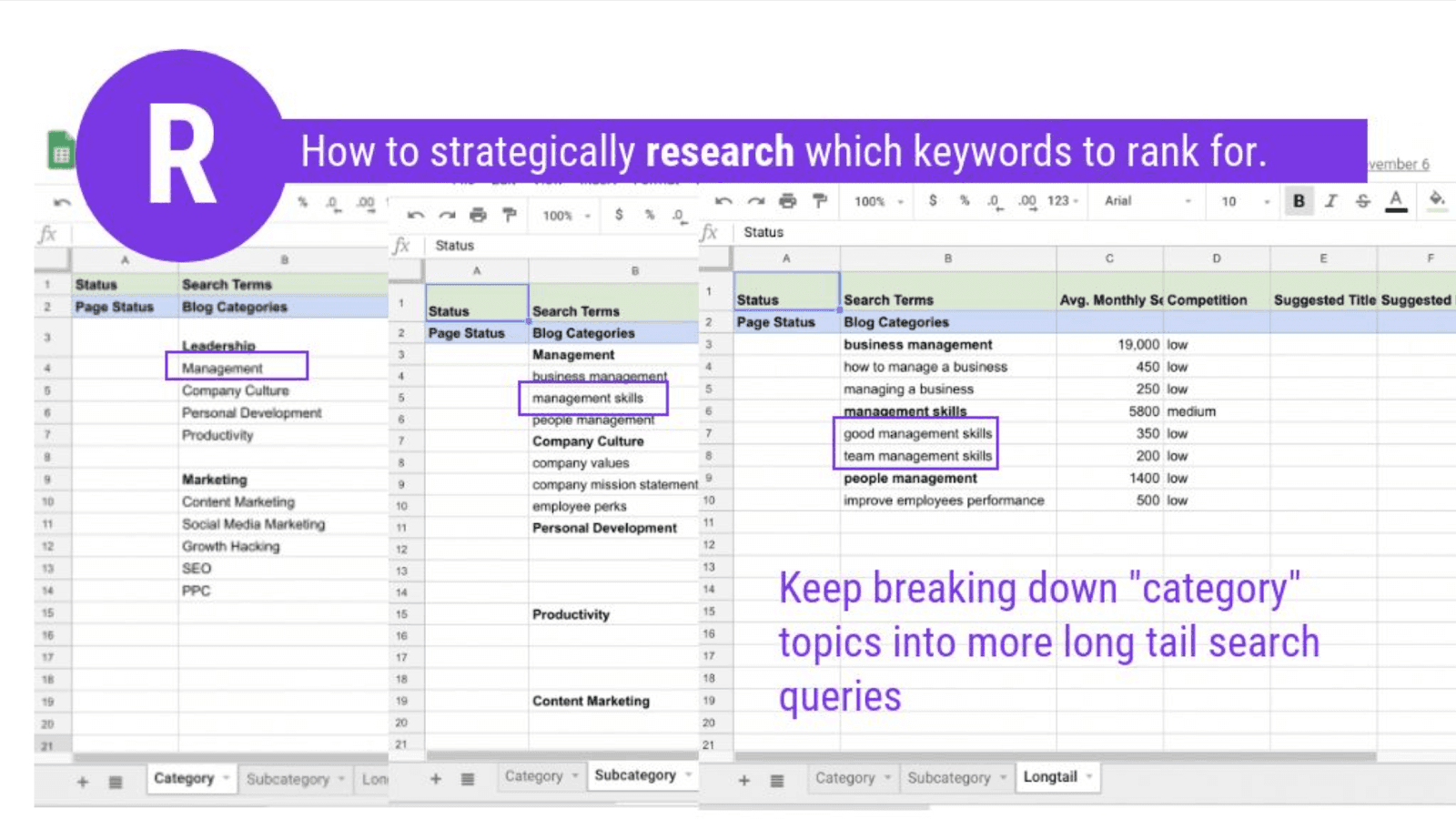 Pro Tip: Break down your COS into categories, subcategories and long tail keywords to effectively generate more ideas on what to write about.
For example: You probably have one primary category when it comes to your blog content like leadership, marketing or even design.
Now, within these all encompassing categories, there are subcategories that you can research and build on.
So within the topic of “leadership” one might also include:
Pro Tip: Break down your COS into categories, subcategories and long tail keywords to effectively generate more ideas on what to write about.
For example: You probably have one primary category when it comes to your blog content like leadership, marketing or even design.
Now, within these all encompassing categories, there are subcategories that you can research and build on.
So within the topic of “leadership” one might also include:
- Management.
- Company culture.
- Productivity, etc as subcategories.
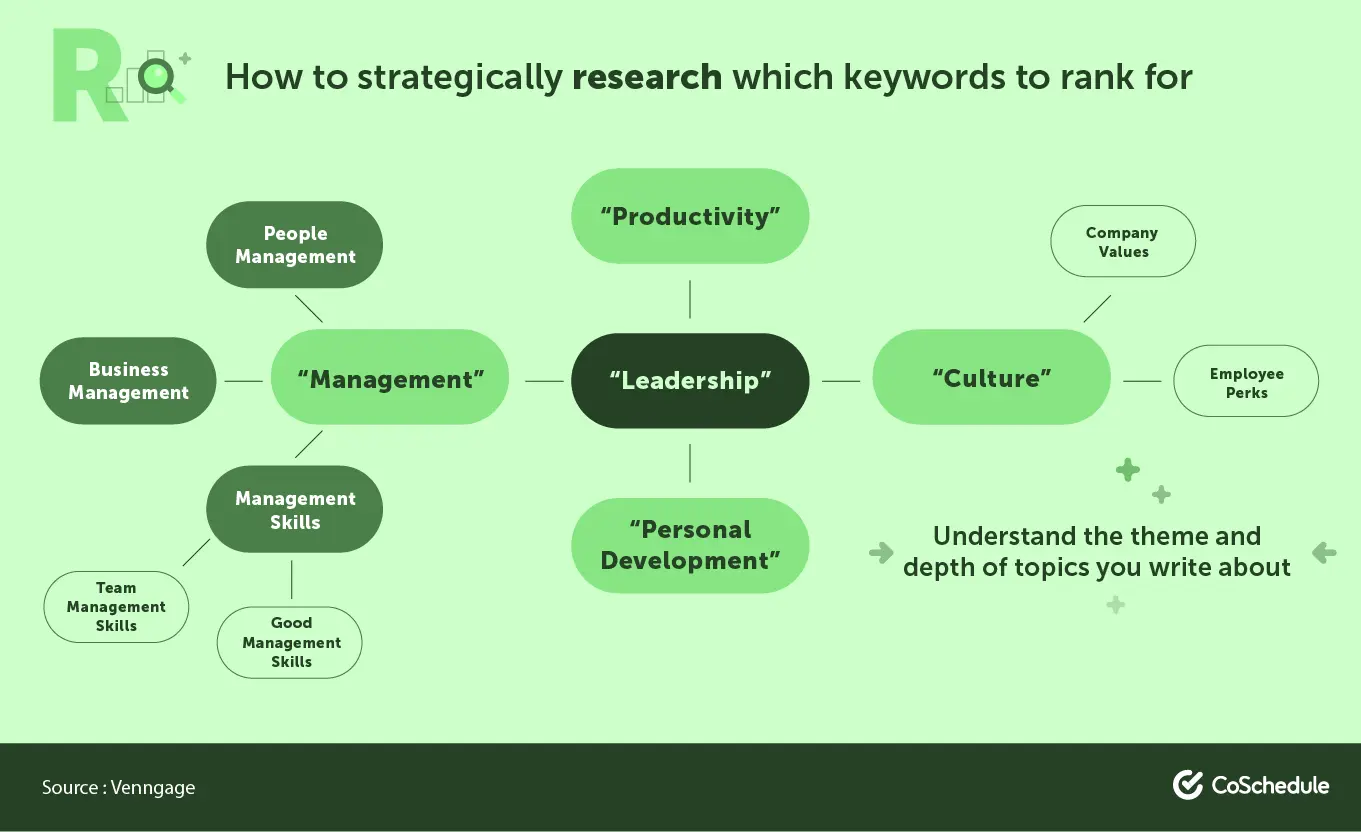 When you flowchart your content ideas, it’ll help you get a better understanding of the theme and depth of topics you are going to write about.
This process might be time consuming and complex, but it's a necessary evil if you want to increase your web traffic and scale it effectively.
It also helps you keep the focus on creating quality content that engages your audience and establishes authority for your site which is coincidentally, also the next part of this framework.
When you flowchart your content ideas, it’ll help you get a better understanding of the theme and depth of topics you are going to write about.
This process might be time consuming and complex, but it's a necessary evil if you want to increase your web traffic and scale it effectively.
It also helps you keep the focus on creating quality content that engages your audience and establishes authority for your site which is coincidentally, also the next part of this framework.
3. Authority
Establishing content authority is really important if you want to maximize the impact your content strategy has on your business goals.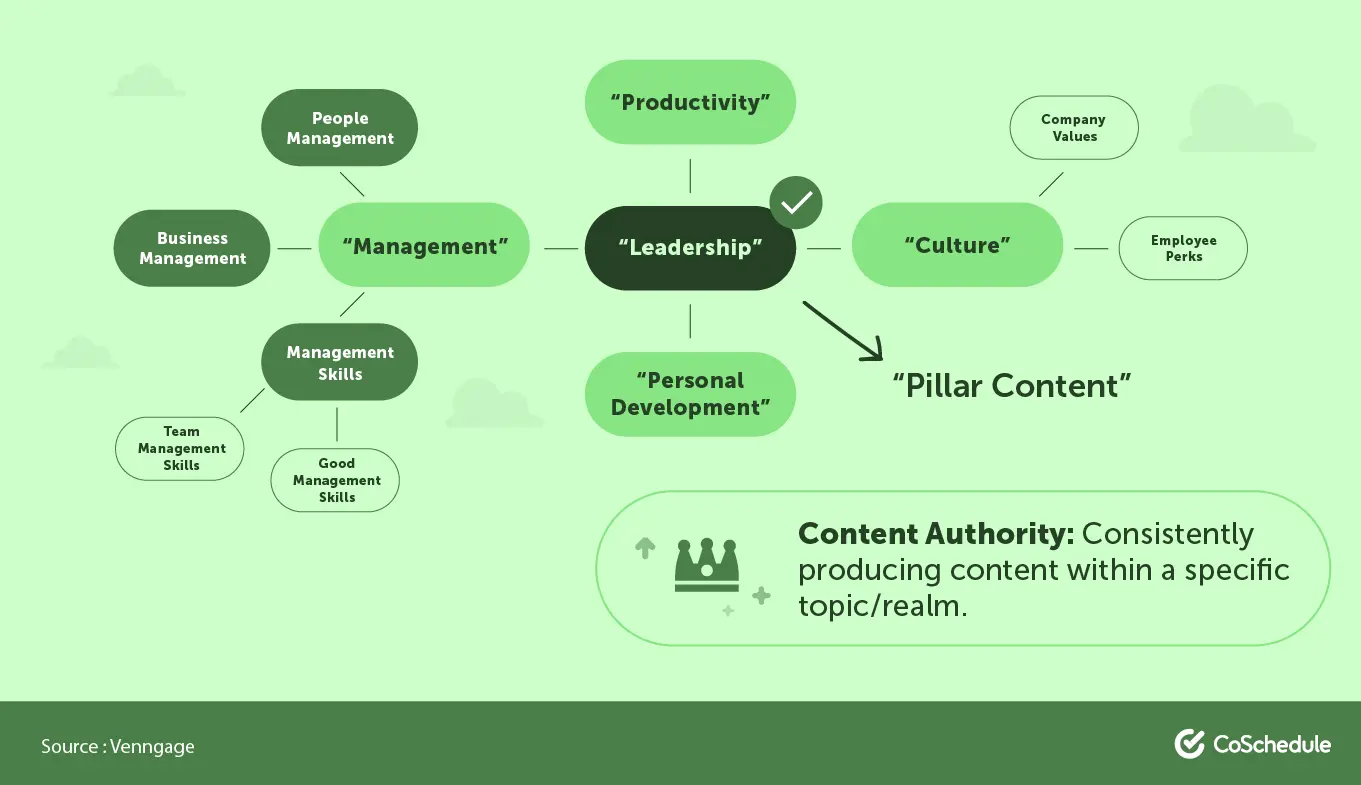 But what is content authority? It’s similar to the concept of creating “content clusters” or producing content that falls within a specific niche, topic or realm.
Do this long enough and eventually you become known by people (and search engines) as an authority on that subject.
In Venngage’s instance, we produce a lot of content around design and infographics. As a result we’ve been able to establish a significant authority for design and infographic related content.
But what is content authority? It’s similar to the concept of creating “content clusters” or producing content that falls within a specific niche, topic or realm.
Do this long enough and eventually you become known by people (and search engines) as an authority on that subject.
In Venngage’s instance, we produce a lot of content around design and infographics. As a result we’ve been able to establish a significant authority for design and infographic related content.
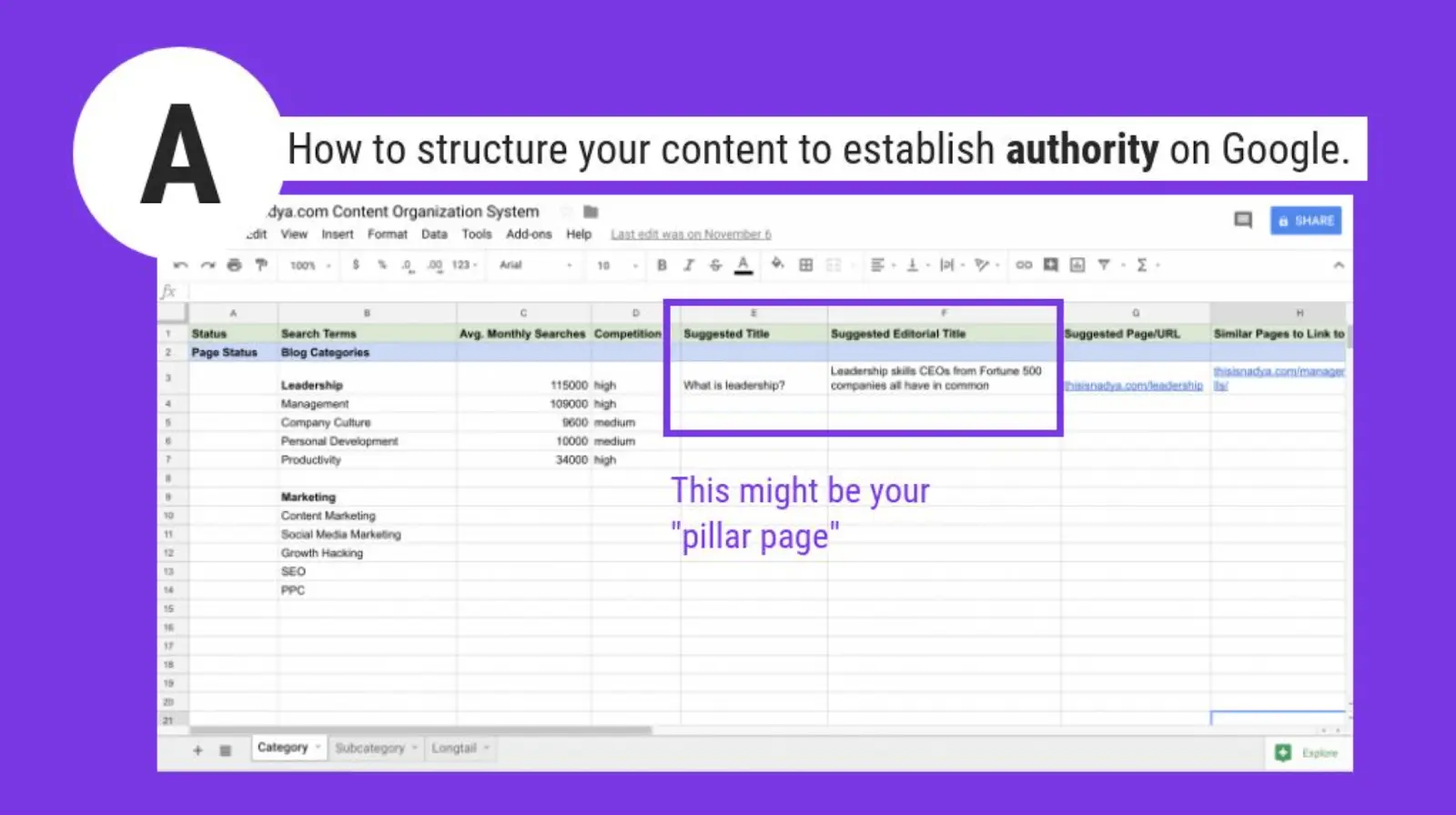 And this is where the Content Organization System we discussed earlier comes in handy.
If you notice, there’s a column for “suggested title” as well as “suggested editorial/viral title”.
Now you can start figuring out what type of content to write about based on the keyword research we did earlier as well as how to position said content as either an actionable or a viral/editorial piece of content.
This research on “categories” will eventually guide the pillar content pages you create (or the “hub” content).
Eventually you can build out a web of inter-related topics that essentially create bubbles or a “cluster” of content on your site related to the pillar or category topic.
And this is where the Content Organization System we discussed earlier comes in handy.
If you notice, there’s a column for “suggested title” as well as “suggested editorial/viral title”.
Now you can start figuring out what type of content to write about based on the keyword research we did earlier as well as how to position said content as either an actionable or a viral/editorial piece of content.
This research on “categories” will eventually guide the pillar content pages you create (or the “hub” content).
Eventually you can build out a web of inter-related topics that essentially create bubbles or a “cluster” of content on your site related to the pillar or category topic.
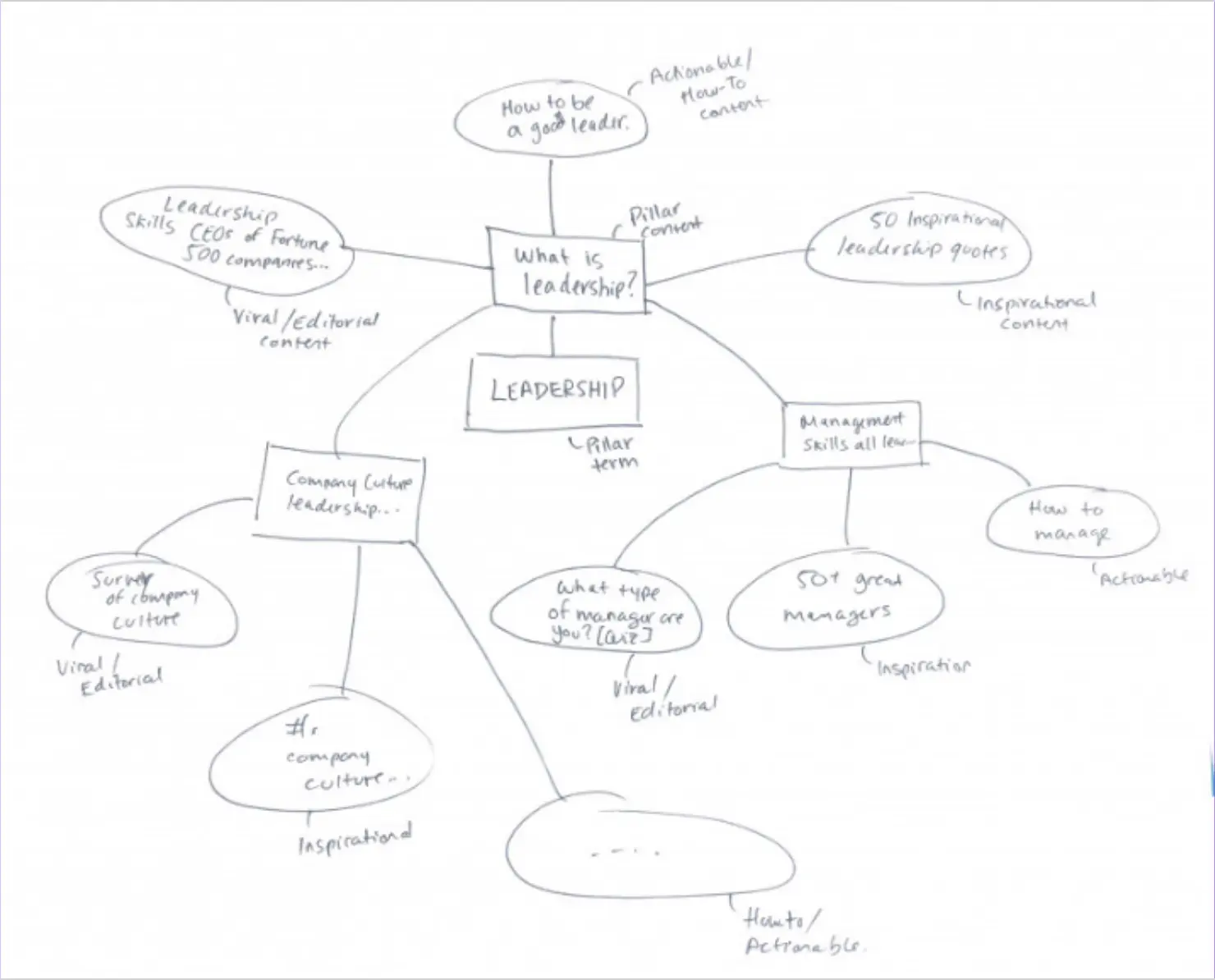 So your cluster on leadership might look something like the example above. And if you can keep up with the madness, you can slowly start to see how your content goals start coming into the picture here.
The only thing to keep in mind is, the more quality content you produce, the more complex these clusters will become.
Your actionable, inspirational and viral content will fall into this cluster.
So your cluster on leadership might look something like the example above. And if you can keep up with the madness, you can slowly start to see how your content goals start coming into the picture here.
The only thing to keep in mind is, the more quality content you produce, the more complex these clusters will become.
Your actionable, inspirational and viral content will fall into this cluster.
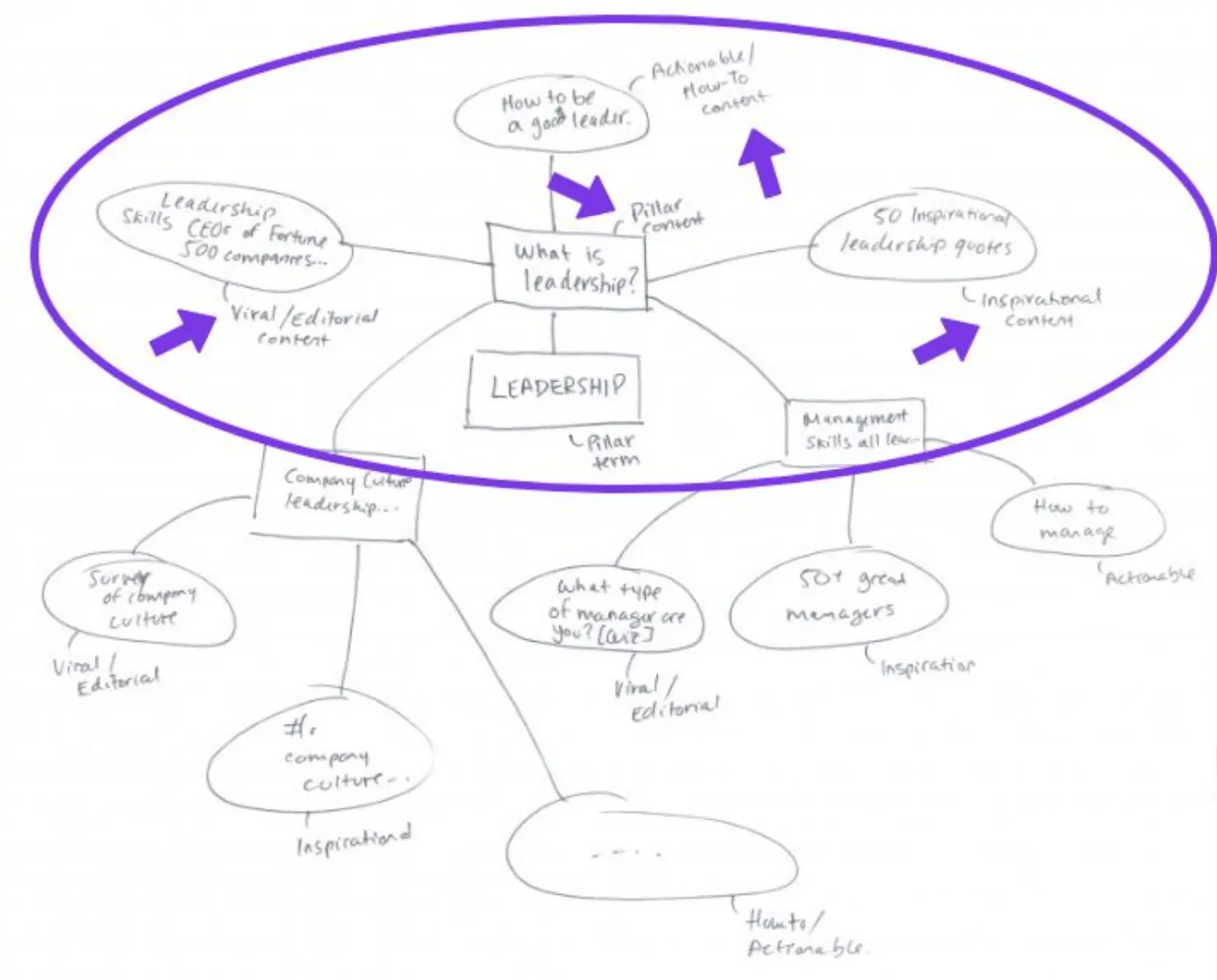 So if you start with, “What is leadership?” as a pillar informational piece of content, you can expand on it:
So if you start with, “What is leadership?” as a pillar informational piece of content, you can expand on it:
- Actionable/how to guide: “How to be an effective leader?”
- Inspirational content: “50 inspirational leadership quotes to inspire you”.
- Viral/editorial content: “Leadership skills CEOs from Fortune 500 companies all have in common”.
4. Promotion
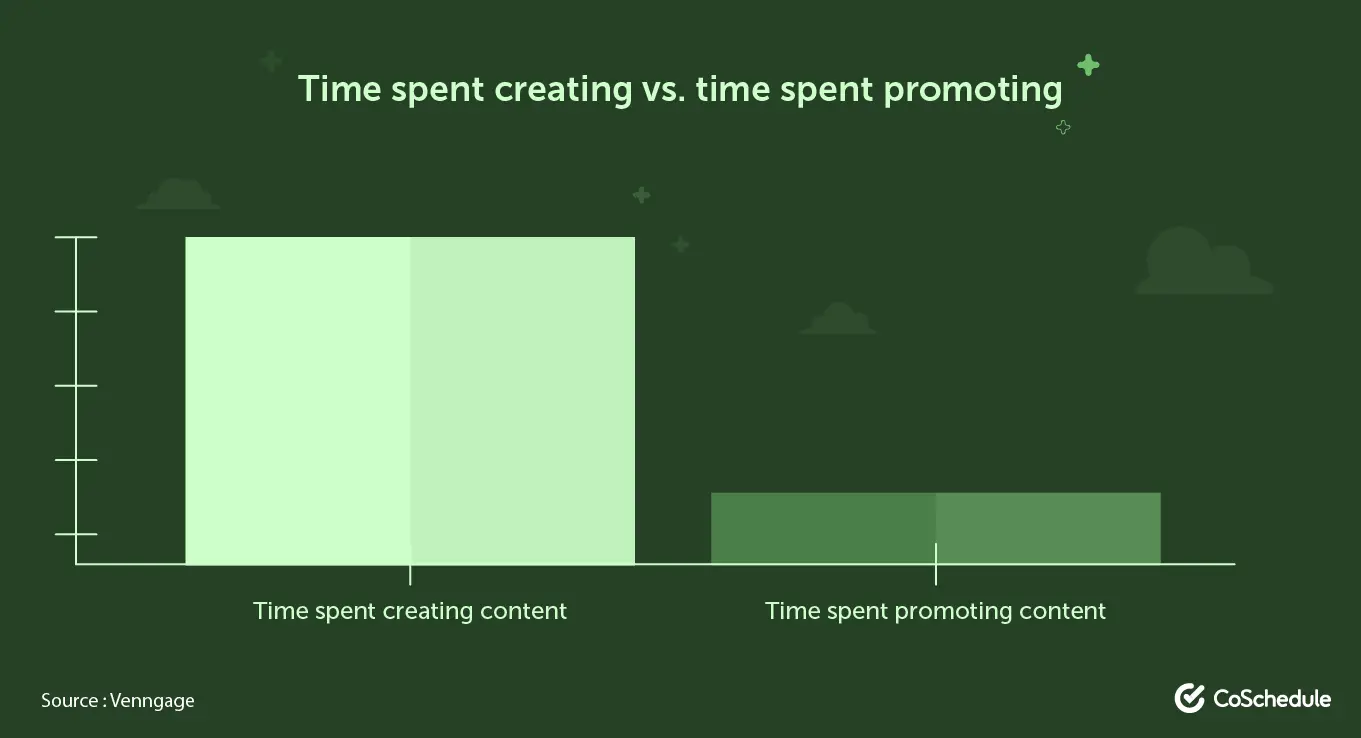 The unfortunate truth is that too many people spend more time creating content but not enough time promoting it.
Once you’ve created content that has a specific goal, is keyword-driven and authoritative, the final step is getting it in front of the right people.
Let’s look at an example of one of our “content marketing experts”, as you can see the Top 10 pages driving organic traffic back to their site start off high but the volume fizzles out really fast.
The unfortunate truth is that too many people spend more time creating content but not enough time promoting it.
Once you’ve created content that has a specific goal, is keyword-driven and authoritative, the final step is getting it in front of the right people.
Let’s look at an example of one of our “content marketing experts”, as you can see the Top 10 pages driving organic traffic back to their site start off high but the volume fizzles out really fast.
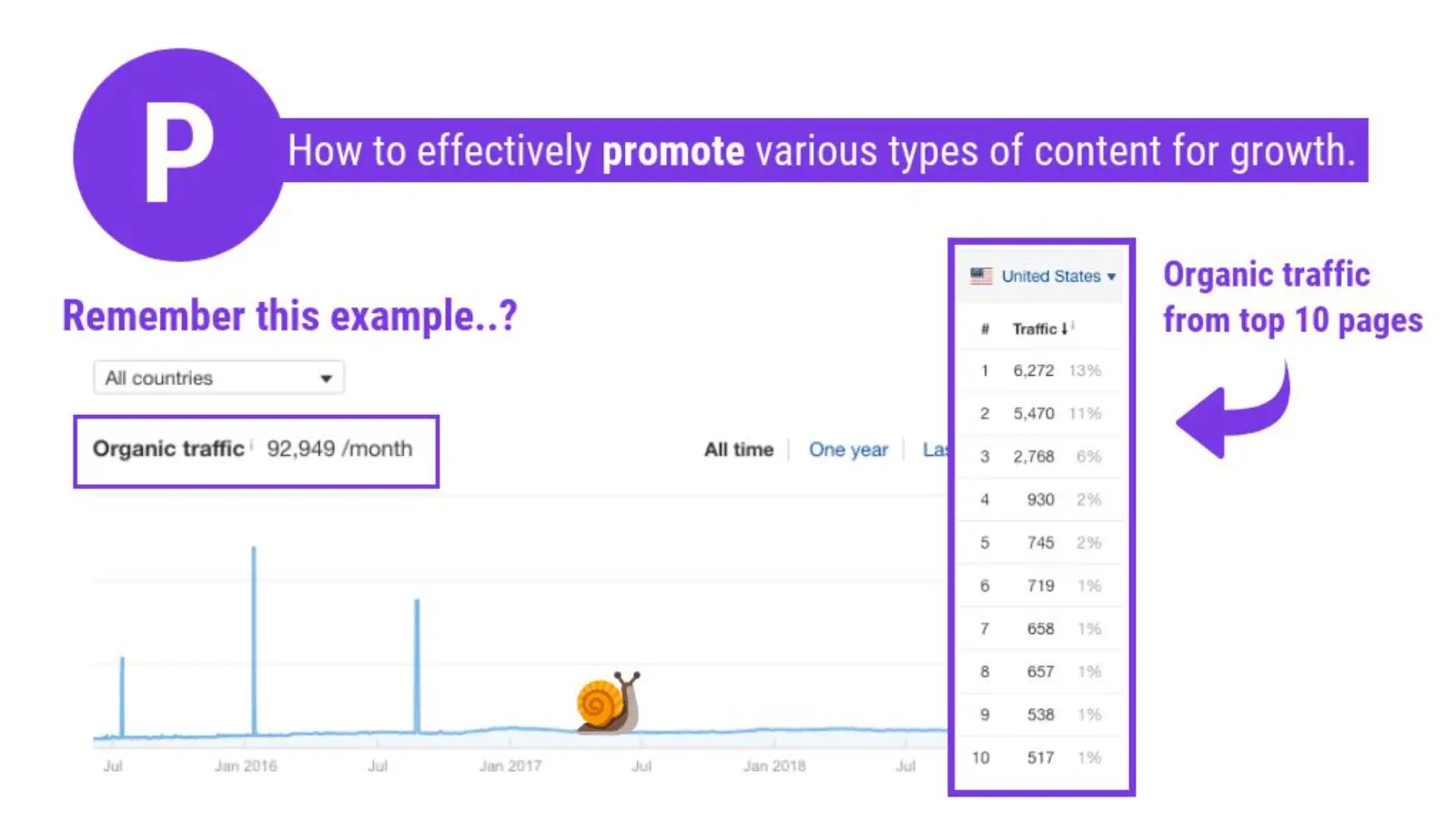 If we go back and look at this example from one of our “content marketing experts”, as you can see the top 10 pages driving organic traffic to their site start off with considerable traffic volume, but it fizzles off really fast.
The same site has 5,000+ blog posts published and they’re creating new content on a consistent basis.
What’s even more alarming is that less than 500 of those pages are actually driving any tangible traffic at all.
If we go back and look at this example from one of our “content marketing experts”, as you can see the top 10 pages driving organic traffic to their site start off with considerable traffic volume, but it fizzles off really fast.
The same site has 5,000+ blog posts published and they’re creating new content on a consistent basis.
What’s even more alarming is that less than 500 of those pages are actually driving any tangible traffic at all.
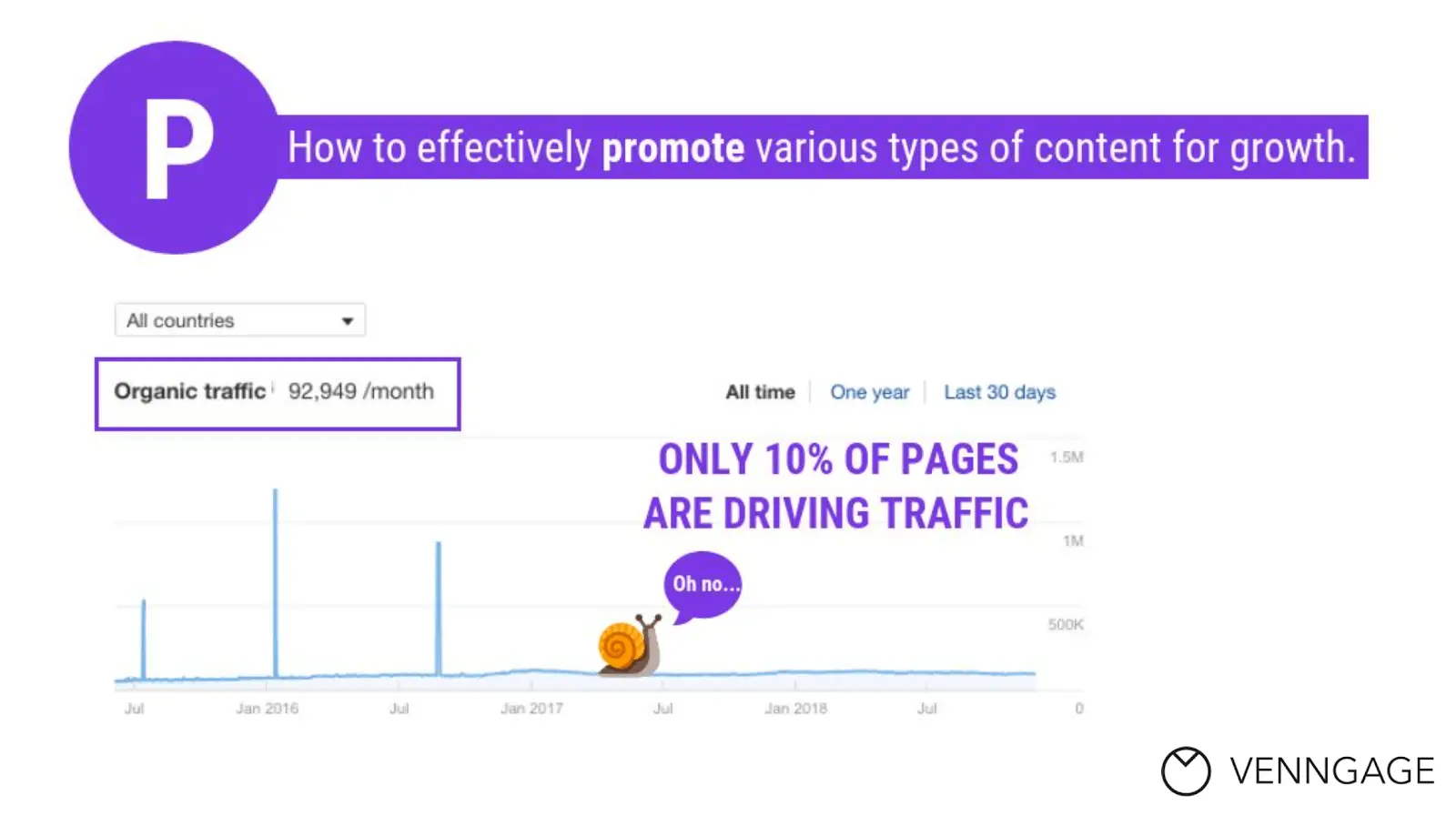 If you think about it logically, only 10% of their pages (and I’m not just talking blog content) are driving any real traffic back to their site. And the remaining 90% of content is essentially doing nothing for their web traffic.
What I’m trying to say is: just creating quality content isn’t enough.
Derek Halpern of Social Triggers once said:
If you think about it logically, only 10% of their pages (and I’m not just talking blog content) are driving any real traffic back to their site. And the remaining 90% of content is essentially doing nothing for their web traffic.
What I’m trying to say is: just creating quality content isn’t enough.
Derek Halpern of Social Triggers once said:
“Content promotion should take 80% of your time while content creation should take up only 20% of your time”.A golden rule Nadya often reminds the team to stick to is, promoting content should take up more time than creating it. Everytime. Of course, depending on the type of content you’re creating and the goals you have in mind, you need to approach promotion differently for each type of content to see different results.
 Pro tip: A monumental part of ensuring your content marketing strategy is and remains successful throughout the duration of its entire execution is that you consistently run SEO audits and track what works against what doesn’t. Make sure that you aren’t losing traffic to content that is “decaying” and win it back by refreshing it with an update.
For viral content, as we discussed the goal is getting high quality backlinks but you probably won’t get an upsurge in web traffic from it. Or even conversions for that matter.
So focus on reaching out to press sites or high DA sites.
For actionable or inspirational content, your goal wouldn’t be press mentions (as this type of content isn’t newsworthy).
So instead we focus on reaching out to sites operating in the same niche or writing about similar topics (like marketing blogs in our instance) and building links on those sites which point back to our content.
This can be achieved through a variety of ways, some of which are by:
Pro tip: A monumental part of ensuring your content marketing strategy is and remains successful throughout the duration of its entire execution is that you consistently run SEO audits and track what works against what doesn’t. Make sure that you aren’t losing traffic to content that is “decaying” and win it back by refreshing it with an update.
For viral content, as we discussed the goal is getting high quality backlinks but you probably won’t get an upsurge in web traffic from it. Or even conversions for that matter.
So focus on reaching out to press sites or high DA sites.
For actionable or inspirational content, your goal wouldn’t be press mentions (as this type of content isn’t newsworthy).
So instead we focus on reaching out to sites operating in the same niche or writing about similar topics (like marketing blogs in our instance) and building links on those sites which point back to our content.
This can be achieved through a variety of ways, some of which are by:
- Guest blogging,
- Linkbuilding through blogger outreach.
- Building long term partnerships, etc.
 Assuming, we have an article written or optimized for the keyword “infographic design”, I simple search for the same term on Ahrefs’ “content explorer” tool.
Press search and out pops the pieces of content written by people around that subject.
Assuming, we have an article written or optimized for the keyword “infographic design”, I simple search for the same term on Ahrefs’ “content explorer” tool.
Press search and out pops the pieces of content written by people around that subject.
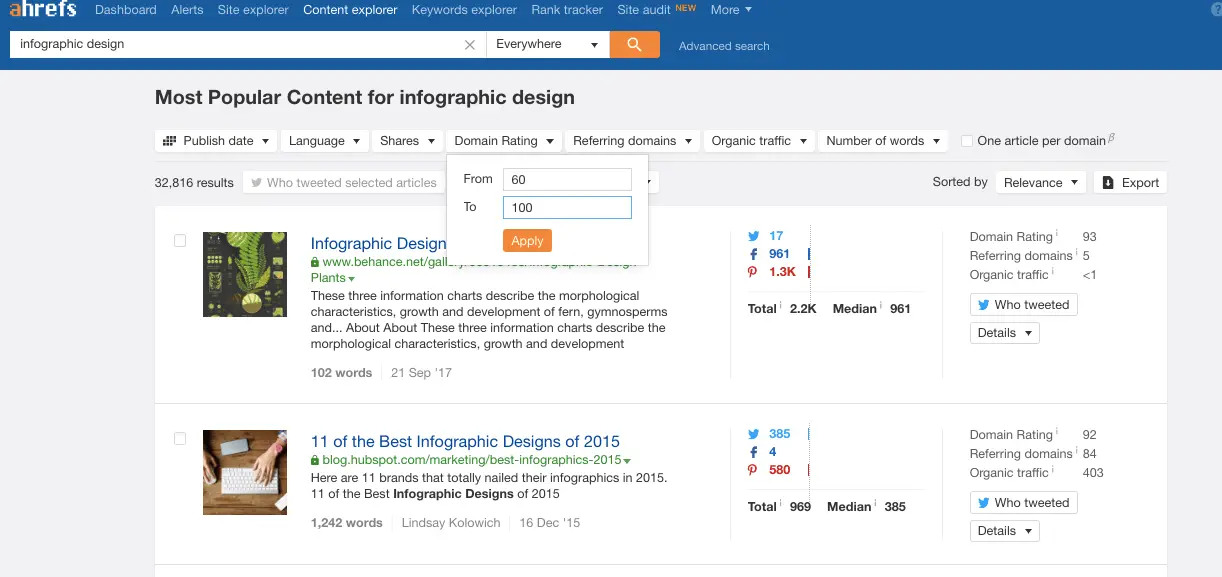 The next step is to filter the results by DA (Domain Authority) so that we only focus on reaching out to high quality sites. (At Venngage, we usually only reach out to 60 DA sites or higher).
The resulting list will be much shorter now. Download it.
The next step is to filter the results by DA (Domain Authority) so that we only focus on reaching out to high quality sites. (At Venngage, we usually only reach out to 60 DA sites or higher).
The resulting list will be much shorter now. Download it.
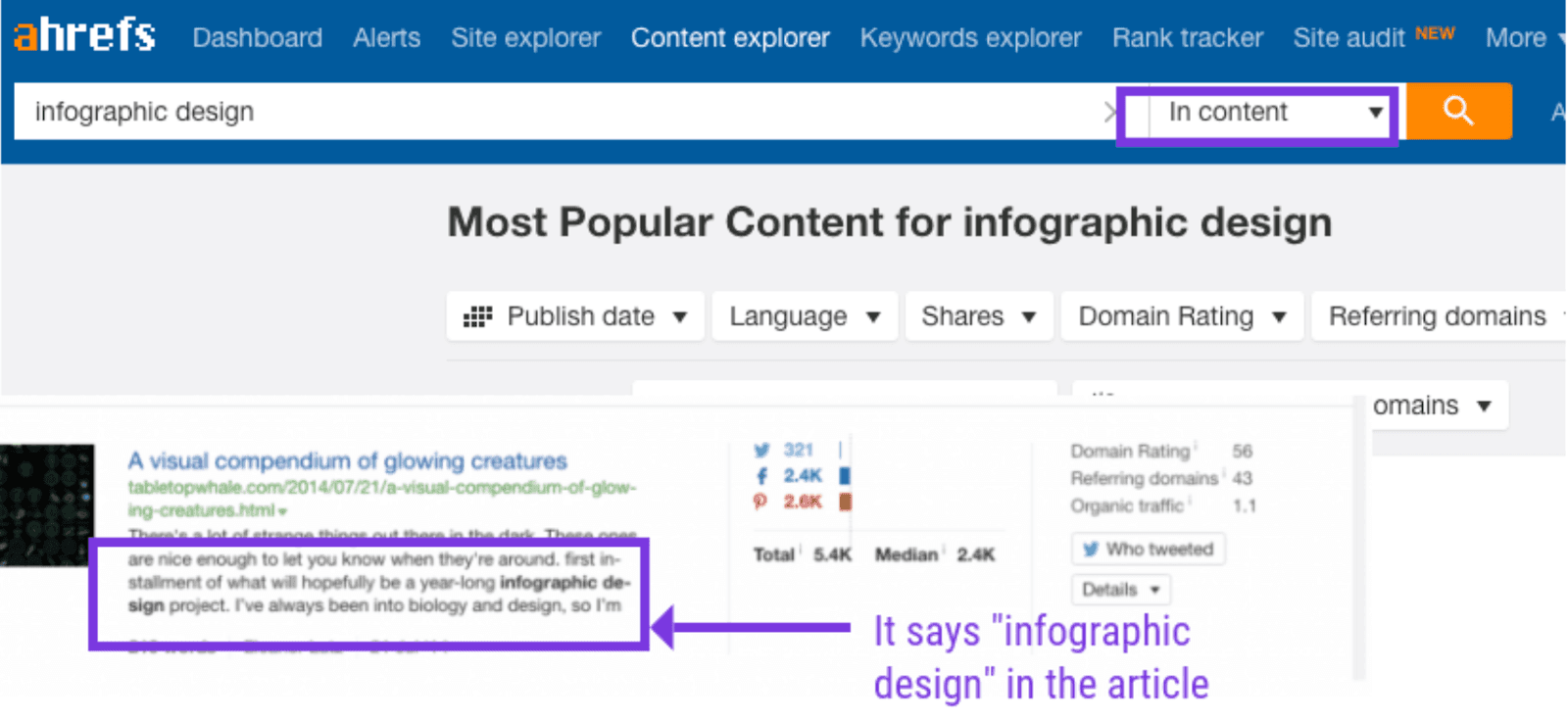 Pro tip: When building your outreach lists using Ahrefs, select the “In Content” parameter next to the search bar (instead of “Everywhere”) and then hit search. Why? Because if you build a list with your target keyword being in the title of the content, chances are those prospects are trying to rank for that term themselves and will most likely not link to you.
Pro tip: When building your outreach lists using Ahrefs, select the “In Content” parameter next to the search bar (instead of “Everywhere”) and then hit search. Why? Because if you build a list with your target keyword being in the title of the content, chances are those prospects are trying to rank for that term themselves and will most likely not link to you.
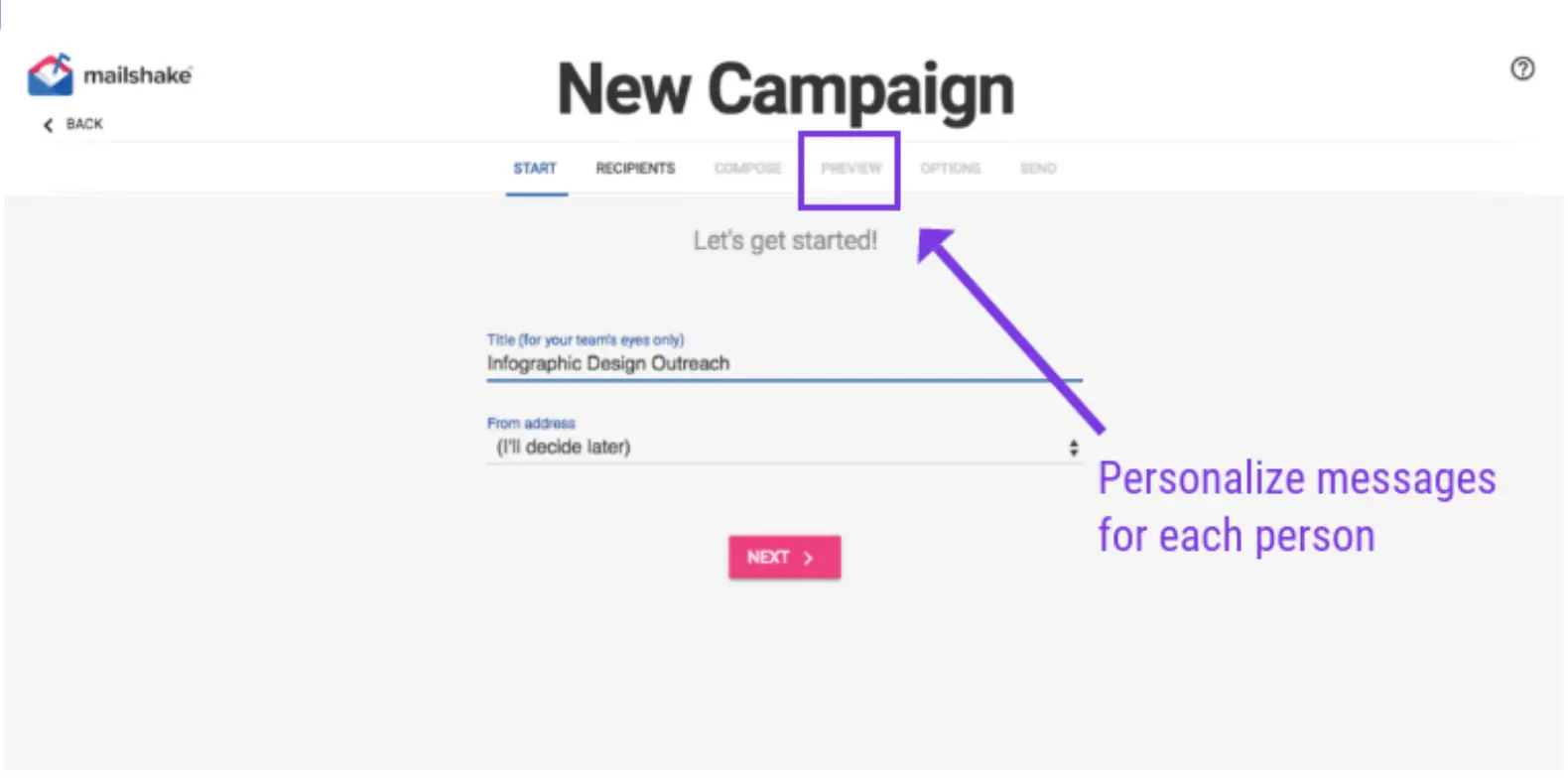 Finally, load up your list of prospects on Mailshake. And boom! You’re now ready to build some links!
To sum up how Venngage approaches content promotion aka outreach, here are some best practises:
Finally, load up your list of prospects on Mailshake. And boom! You’re now ready to build some links!
To sum up how Venngage approaches content promotion aka outreach, here are some best practises:
- Play the long game. View linkbuilding as a long term relationship, not a one-off strategy. Lay the groundwork and reap bigger rewards later on.
- Make people care. Try not to sound like a robot, the person receiving your email is a human after all.
- Don’t be apologetic. Be confident about the content you’re promoting.
- Cull your lists. Remove competitors and make sure the content you’re referencing in your pitch is actually relevant to the link you want.
- Be yourself. Inject your personality to stand out from the crowd.
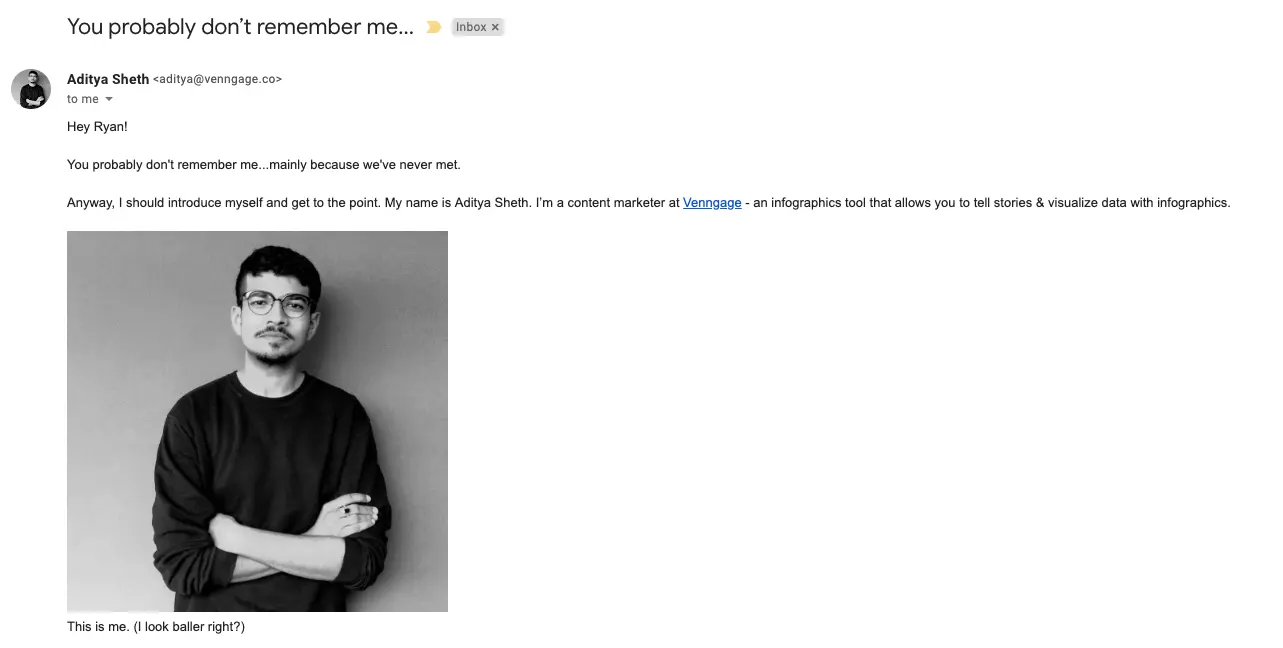 This is one of my outreach emails I use frequently. It starts off with a joke and makes me appear as someone who doesn’t take themselves too seriously.
The end goal is to come across as a human being rather than a robot using templated responses.
One more thing.
Give your prospects a reason to care about what you’re doing. The more they care, the better your chances are of you getting that link.
This means short and sweet doesn’t necessarily work all the time. While I’m a huge proponent of straight to the point emails, sometimes you need to engage in a little bit of storytelling to establish a deeper connection with your prospect.
Pro Tip: Linkbuilding is an iterative process. What worked a few years ago will probably not work today. So keep tweaking your methods and improving your linkbuilding tactics to see the right results, consistently.
This is one of my outreach emails I use frequently. It starts off with a joke and makes me appear as someone who doesn’t take themselves too seriously.
The end goal is to come across as a human being rather than a robot using templated responses.
One more thing.
Give your prospects a reason to care about what you’re doing. The more they care, the better your chances are of you getting that link.
This means short and sweet doesn’t necessarily work all the time. While I’m a huge proponent of straight to the point emails, sometimes you need to engage in a little bit of storytelling to establish a deeper connection with your prospect.
Pro Tip: Linkbuilding is an iterative process. What worked a few years ago will probably not work today. So keep tweaking your methods and improving your linkbuilding tactics to see the right results, consistently.
Applying the GRAP Framework
Many marketers may not consider content marketing to be the same as growth marketing. But approaching content like a growth marketer by taking a data-driven and iterative approach to growth has been our secret weapon to increasing web traffic at a predictable rate. So how do you apply the GRAP Framework to your content marketing endeavours? Keep these crucial pointers in mind:- Establish specific goals for specific pieces of content.
- Start with keyword research to give yourself a head start.
- Consistently produce content within a specific niche, topic or realm.
- 80% of your time should be spent on content promotion, 20% in content creation.
